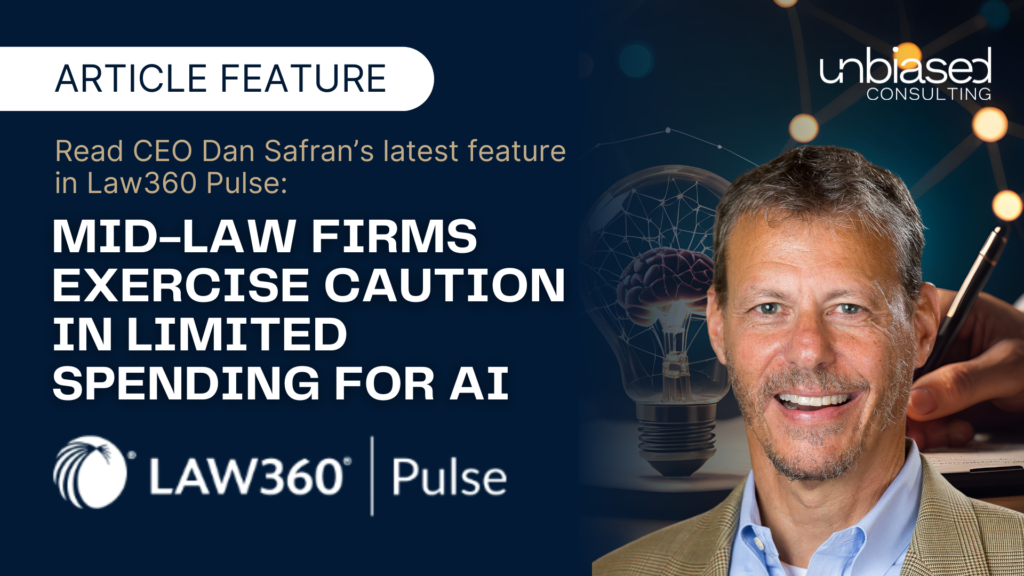Written By: Editor Emma Cueto
Featured in Law360 Pulse
With smaller legal technology budgets than their Big Law cousins, Mid-Law firms are cautiously making investments in AI tools with an eye on utilizing the technology in low-risk and cost-effective ways.
Amid the proliferation of AI tools for lawyers, some tools are too pricey for mid-size, mid-market and regional firms, which are being careful not to overspend or lock themselves into subscriptions that don’t ultimately pay off. However, firms are investing both in the tools themselves and in the personnel to vet and manage them.
The ever-proliferating AI tools on offer promise to help firms with practice of law tasks, such as legal research and document review, and with administrative tasks like timekeeping, but finding room in their budgets can be trickier.
“Can we jump in head first? No,” said Melanie Chaney, managing partner of California firm Liebert Cassidy Whitmore. “A big firm might be able to absorb that cost easier or better, but for us, it’s about looking at, ‘Is this an investment we can afford to make, and what kind of benefit we are going to get out of it?'”
The cost of AI tools can vary widely across vendors, but Robert Mattern of law firm consulting firm Mattern Associates said that, in general, subscriptions for most tools aimed specifically at law firms will run a firm between $300 and $800 per lawyer per month — which for a mid-size firm makes any firmwide implementation a six-figure annual expense.
Accordingly, Mid-Law firms have proceeded carefully, though multiple firms told Law360 they’ve found many vendors are open to negotiation.
We’ve found that a lot of companies are willing to make adjustments and be very collaborative in their “cost scale,” said Michelle Six, a litigator at Gunster who counsels clients on AI technology and data privacy matters and is also part of a group guiding AI implementation at the firm.
Six said the firm has looked for use cases that increase efficiency and limit risks like hallucination, such as to compare documents, while being more wary of products like note takers, where data security might be an issue.
The firm is keeping its approach grounded in its clients’ needs and expectations, she said, with some clients expecting the firm to use AI and other clients preferring that it not use AI for their matters.
Firms said they are also investigating ways that generative AI can be used in firm administration, such as timekeeping tools that make lawyers more effective at logging their billable hours. Mattern said this was a smart move more firms should be considering.
“I think a lot of firms are dabbling [with administrative uses], but it’s not the focus,” Mattern said. “Why not use it on the backend to free up attorneys … to give them more time to bill?”
At Rutan & Tucker LLP, the firm has thus far stuck with tools from known vendors like Microsoft, with director of knowledge management Kyre Stucklin saying that she hasn’t found more niche tools to be as cost-effective and that many of them don’t scale well. The firm has also experimented with licensing tools for short durations for specific projects on specific matters — a more cost-effective approach than locking the firm into a long-term contract, according to Stucklin.
Stucklin said that in some cases she’s been surprised that some tools are affordable. However, she added, she’s wary of companies that may be signing people up at a “loss leader” rate in order to get customers and may one day jack up prices.
Consultant Dan Safran stressed that Mid-Law firms should be looking for the most cost-effective or lowest-risk places to incorporate AI.
“I’m maybe a little contrarian about this stuff,” he said, explaining that he sees the hype around generative AI as outpacing the actual return on investment law firms are seeing.
Mid-size firms, he said, should keep a grounded cost/benefit analysis in mind and shouldn’t feel pressure to be early adopters for the sake of it.
The current landscape for AI tools is like the “Wild, Wild West,” he said, and it pays to be careful.
A careful AI approach, however, requires its own investments, namely hiring personnel to navigate the rapidly evolving AI offerings or allowing existing personnel to dedicate substantial time to the project.
Stucklin said researching AI tools, taking meetings with AI vendors, and vetting their offerings has become essentially her whole job.
“Having someone deep diving into AI capability, functionality and security has been really important, “she said, adding, “The human hours put into creating a good AI ecosystem is as important as the tools themselves.”
In particular, she said, she always wants to closely scrutinize the security of the data the tools collect, and she has rejected tools from vendors they have used for non-AI products if she isn’t satisfied with their security.
At Liebert Cassidy, Chaney said the firm hired an AI innovation project manager over the summer. “I think it’s absolutely necessary, in building this firm for the future, to have someone looking at the market and figuring out what are the best tools.”
The firm has looked at options for things like quickly aggregating data, as well as administrative uses like timekeeping, she said, but security and price are important concerns. The firm needs to be comfortable on both points before using something.
“Most lawyers don’t have time to vet these things,” she added. “You need people on your admin team who can devote the time to it.”

